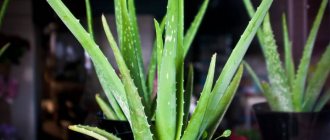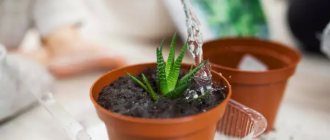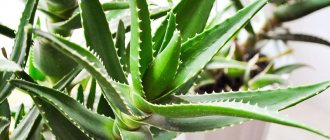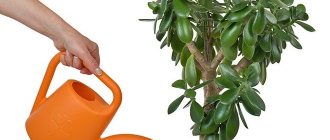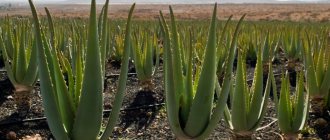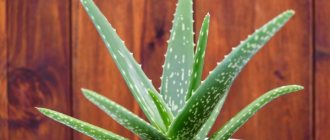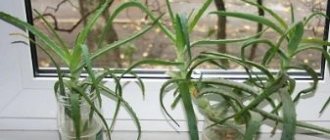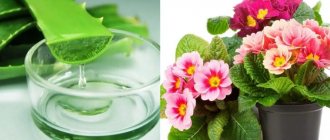You are asking: “Please advise what to water aloe for growth. I took a young bush from a friend, but it stands almost in place, does not grow, but does not disappear. Over the summer I only grew one leaf, and even that one is still short. Maybe there are some folk remedies. Or, as a last resort, ready-made fertilizers specifically for aloe. I would be very grateful for your help."
We answer: Unpretentious aloes, especially medicinal ones, are distinguished not only by their stable nature and ease of cultivation, but also by their slow growth. Not everyone wants to wait until their pet is finally either old enough to be used for treatment or plump enough. Fortunately, this is not required, because there are many ways to water aloe for growth. For those who do not have time to bother with preparation, ready-made preparations - fertilizers - are suitable. It contains a full complex of all necessary aloe nutrients. And adherents of “healthy eating” for their green pets and simply those who like to experiment have plenty to choose from among folk remedies.
What fertilizers are suitable for aloe?
Aloe, commonly known as agave, is a unique plant that is widely used not only in folk medicine, but also in traditional medicine and the cosmetics industry.
There are over 350 species of agave in nature. At the same time, only 2 varieties are suitable for medicinal purposes: vera and aloe vera. In this article we will talk about which fertilizer is best suited for growing aloe at home and other nuances of care.
Is it possible not to use fertilizers?
If the life of a succulent does not mean very much to the owner, then yes, you can. But if the presence of healthy and healthy aloe in the room is very important, then you cannot do without fertilizers. After just six months of growing a succulent without fertilizers, characteristic signs of hunger will begin:
- pale leaves;
- white border along the contour of the leaves;
- lack of pomp and growth.
And the more time you do not feed the plant, the worse it will be - this usually ends in the death of the flower with the impossibility of “resurrecting” it.
You can and even need to feed aloe with inorganic fertilizers every 1-2 weeks. This is what stimulates growth, strengthens the succulent’s immunity and makes its overall appearance healthy. In addition, we should not forget that the health of the plant ultimately determines its usefulness for medical use.
Beneficial properties of aloe
Agave has been used in folk medicine since ancient times for:
- treatment of cold symptoms: rhinitis, conjunctivitis, cough;
- treatment of various gastrointestinal diseases: constipation, hemorrhoids, intestinal polyps;
- for the treatment of liver failure, problems with the pancreas;
- treatment of dermatological diseases;
- normalization of blood glucose levels.
It also shortens the rehabilitation period after treatment of serious diseases: chemotherapy, taking medications for the treatment of tuberculosis, autoimmune diseases. Aloe juice is added to various cosmetic preparations. Thanks to the antiseptic and anti-inflammatory properties of aloe vera plants, gels and creams, they relieve skin irritation, moisturize it, tighten pores, and eliminate comedones.
What are aloe vera and agave, what is the difference between them, where is the plant’s homeland of origin?
Aloe is an excellent remedy that helps relieve pain and speed up the healing process of cuts, and also cures chronic diseases. There are many varieties of this plant. But the most common in our region are:
- Aloe arborescens (also called “agagave”)
- Aloe vera
Aloe is a succulent plant that does not require a lot of watering. In winter it needs to be watered no more than once a month, in summer a little more often.
IMPORTANT: There are no more than 500 plant species, which are mainly distributed in Africa and the Arabian Peninsula.
Medicinal properties of the plant:
- Relieve pain and speed up healing of cuts
- Facilitates the course of bronchopulmonary disease
- Reduces pain in stomach diseases
- Improves the situation with eye diseases
- Aloe is indispensable in cosmetology for skin and hair
- The plant has many useful components that strengthen the immune system.
Beneficial properties of aloe
Aloe has both pulp and juice. The thick lower leaves are suitable for pulp. When the tip of the leaf begins to dry out a little, this means that the plant has given up the maximum share of nutrients and the leaf is ready for use.
To use the pulp, you need to put the leaf in the refrigerator for several days and, after rinsing with boiled water, remove the skin. Now the pulp can be used.
Agave is most often used for external use, namely for:
- Healing wounds and eczema
- Soothing dermatitis
- Healing boils
- Acceleration of tissue regeneration in case of burn or frostbite
- Relieving varicose veins
- Skin moisturizing
- Reduce wrinkles
- Reduce itching from insect bites
- Strengthen hair, get rid of dandruff
- Smoothing postoperative scars
Aloe vera is used for internal use, namely for:
- Strengthening the immune system
- Stabilization of blood sugar levels
- Preventing Digestive Disorders
- Strengthening the heart muscle
- Solutions to gum problems
- Reducing inflammation in arthritis
- Improving the functioning of the genitourinary system
But there are also contraindications for the use of both plants. So:
- Aloe vera should not be used by people with low blood sugar, as this plant can lower the level even further.
- People who have experienced vascular spasm should also be careful when consuming the plant. Since aloe causes the blood vessels to become even wider.
- It is also not advisable for pregnant women to consume aloe. The risk of bleeding cannot be excluded.
- Agave is prohibited for oncology, as it promotes cell growth in the body and it is possible that cancer cells will multiply when using the plant.
- For purulent wounds, first you need to remove the pus, and only then use agave. Since the skin on top will heal, but the pus inside will remain.
Aloe as fertilizer for flowers
Below we will consider what measures need to be taken to ensure that the stems of this succulent are healthy and fleshy, and the plant itself pleases the owners with a beautiful appearance and has all the listed beneficial properties. After all, a weak, fading and dried specimen contains practically no life-giving juice. But it is noteworthy that aloe itself is very suitable for fertilizing plants. Containing vitamins, minerals and trace elements, resinous substances, succinic, cinnamic, malic and a number of other useful acids, agave juice is used as a nutritious fertilizer for weak and poorly developing specimens, as a natural biostimulant that allows you to activate the vital forces of the plant.
To prepare the fertilizer, take the leaves of the plant, wrap them in a dark cloth and keep them in the refrigerator for a week. After this, grind the stems in a blender or grind in a meat grinder, squeeze out the juice, dilute it with water in the following proportions: 1 tsp. juice per 1.5 liters of water. Use the prepared solution to water your house plants.
It is important! You cannot water the plant with undiluted juice!
What to feed to bring you back to life when you are sick?
Fertimix fertilizer, also called vermicompost for cacti and aloe, is very good for “reincarnation”. This drug does not contain chemicals, i.e. it is an organic fertilizer - this is the format of the drug that best brings you back to life.
Mode of application:
- Take 1 liter of clean water.
- Measure out 3 caps of Fertimix and add them to the water.
- Mix.
- Pour at the root.
You cannot use only Fertimix, otherwise you can completely kill the succulent. Watering with the drug should be alternated with the use of mineral fertilizers.
Features of growing aloe at home
Under natural conditions, agave grows in hot Africa. Plants for its processing are also located here. The stems are cut, washed, peeled and packed in sealed plastic bags. The resulting raw materials are sold to cosmetic and medical companies.
But for your own needs, it is quite possible to grow aloe at home. The main thing is to create comfortable conditions for the plant, as close as possible to natural ones: choose the right lighting and soil composition, ensure normal watering, temperature conditions and transplants as they grow, and regularly apply fertilizing.
Priming
Under natural conditions, like all succulents, agave grows in sandstones. Accordingly, at home it is important to prepare soil that is close in composition to the natural environment. Take 10% clay, 50% sand, 20% compost and humus each.
On a note! It is important to use fully ripened humus. To reduce ripening time, use a biological composting accelerator .
Mix all parts of the soil thoroughly and pour it into the pot on top of the drainage layer. When replanting the plant, carefully examine the roots, remove damaged parts and rub them with charcoal, remove the lower leaves and carefully replant the aloe into the pot.
Lighting and watering
In winter, the agave is in dire need of sunlight. Therefore, if there is not enough light in the apartment, for example, all windows face north, artificial lighting should be provided. In summer, on the contrary, too bright sunlight leads to “caking” of the plant. In order for aloe to gradually get used to too bright sun, take it out to the balcony (or veranda, if you live in a private house) in the spring. This should be done gradually: first for 15–20 minutes, then increase the time of “taking solar procedures.” Make sure that the plant is not exposed to rain.
Like all succulents, aloe reacts negatively to heavy watering and does not tolerate stagnant moisture. To prevent the roots of the plant from rotting, pour out the remaining water from the tray after watering. The recommended frequency of watering is once a week.
As for the temperature regime, aloe gets used to all conditions, but feels better in summer at temperatures of 20–26 ° C, and at lower temperatures in winter.
Signs of nutritional deficiency
By looking at the plant, you can understand whether it has enough nutrients or not. In its normal state, aloe delights the owner with rich greenery, strong stems, and “fleshy” leaves.
For nutritional deficiency:
- the stems become thinner;
- growth stops;
- the leaves turn yellow, become smaller and lose their rich color;
- the lower fragments die.
If these signs appear with regular feeding, it is worth transplanting the aloe into a larger pot: it simply does not have enough space in a cramped container.
Aloe feeding
Like any other plant, aloe needs proper feeding. It is easy to suspect a lack of nutrients by the appearance of the plant: the lower leaves fall off, growth slows down, the tips of the leaves turn yellow.
Like all succulents, aloe needs calcium, as well as the traditional potassium, nitrogen and phosphorus, and trace elements.
To avoid harming aloe, follow a number of rules:
- Agave should not be fertilized during hibernation, or in summer in very hot weather;
- For aloe, only root feeding is used, no spraying is carried out;
- there is no need to fertilize the plant immediately after transplantation, wait 2–3 weeks;
- The first feeding of the plant after purchase at a flower shop is carried out a month later;
- Water the soil in the pot generously immediately before applying fertilizer to avoid burning the roots.
Pest and disease control of aloe
The most common diseases of aloe are rot, root and dry, the causative agents of which are often fungi. Fungal infections occur when the flower is kept too waterlogged. The plant softens, droops, the leaves change color from green to yellowish. Gradually, wilting begins and, if timely measures are not taken, the aloe dies.
However, this process can be stopped if changes in the condition of the flower are noticed in a timely manner. If the overflow is not prolonged, the flower is dried and then watered very sparingly. However, if rotting of the root system has already begun, the plant needs to be immediately transplanted into another substrate and a careful examination of the roots.
Putrefactive areas are cut down to living tissue and treated with a fungicide, then dried and planted in a new pot and another soil mixture, without watering for a long time - up to a month. Only after making sure that rotting has stopped, they begin to moisturize very sparingly at first, and resume the watering regime only after completely making sure that the plant has been cured.
Among the pests that can significantly harm aloe are spider mites, which are controlled with the help of acaricides; thrips, scale insects and mealybugs cause a lot of trouble for aloe; repeated treatment of affected plants with systemic insecticides helps to get rid of them.
Organic fertilizers for aloe
To feed the agave, fertilizers of mineral and natural origin are used. At the same time, the latter, due to better digestibility of nutrients, are preferable to use. For aloe, the following organics and folk remedies are used:
- humus - it contains nitrogen and potassium, it is applied once in the spring when watering, and is also used when replanting;
- wood ash – has a balanced composition, optimal for succulents;
- dried and crushed eggshells - reduces soil acidity;
- onion peel – destroys larvae and pests.
Humus Ash Shell Husk
Importance of the procedure
The correct composition and relevance of fertilizing is a guarantee of a healthy and strong plant. The rapid development of aloe begins when it is planted in soil enriched with minerals and of the required consistency.
After 6 months, the soil is depleted, there are fewer and fewer nutrients, and as a result, the succulent begins to starve (you can find out what the soil for a flower should be like here). The bush becomes less lush, growth slows down, the foliage turns pale, and immunity decreases. There is no need to wait for such a state, but six months after the transplant, start taking medications.
How to fertilize for fast growth?
It's no secret that it is the mineral nitrogen that promotes active growth and development. In order for the flower to turn into a lush bush, it should be fed with nitrogenous fertilizers.
- The preparation “Bona Forte” for cacti enjoys a good reputation. This liquid complex fertilizer is designed to stimulate plant growth and nutrition. The active substance is succinic acid. It also contains the following valuable elements: magnesium, boron, iron, cobalt, zinc. And, of course, the main components: potassium, calcium, phosphorus.
What problems does taking aloe vera gel help with?
Aloe vera drinking gel from LR photo
Products made from aloe vera have proven themselves in nutrition and sports medicine. One of the most common biologically active food additives is drinking aloe vera gel.
Aloe-based drinks made from the inside of succulent leaves (high-quality plant raw materials) through special purification and a unique technological process are incredibly popular among people leading a healthy lifestyle in many countries around the world.
Drinking aloe vera gel, reviews of which can be found on numerous forums devoted to the problems of safe treatment and prevention of diseases, helps in restoring the body under conditions of constant stress caused by the modern rhythm of life, unfavorable environmental conditions and various diseases.
For example, drinking aloe vera gels from LR, a German company with an impeccable reputation, are useful for the prevention and treatment of the following pathologies that most people suffer from these days:
- Diseases of the digestive system, including peptic ulcers, gastritis, flatulence, dysbacteriosis, colitis, etc.;
- Diabetes mellitus, obesity and other metabolic disorders in the body;
- Dermatological diseases, including acne, eczema, furunculosis, carbunculosis, atopic dermatitis, psoriasis, etc.;
- Bronchial asthma;
- Inflammatory processes in the respiratory organs;
- Allergies of various origins.
Nuances of culture propagation
When growing aloe, sooner or later the question of its reproduction arises. There are the following ways to get a new plant:
- Using cuttings.
- Radical shoots.
- Seeds.
- Upper shoots.
Cuttings, pruning top shoots and root shoots are the simplest options if the question is how to grow aloe quickly. Propagation by seeds is suitable only for the most patient gardeners.
